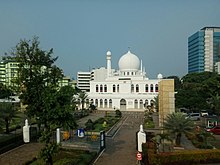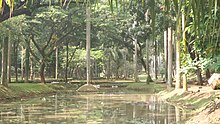Cilandak is a district in the administrative city of South Jakarta, Indonesia. The Krukut River flows through the eastern edge of Cilandak, while the Pesanggrahan and Grogol Rivers flow through the western edge.
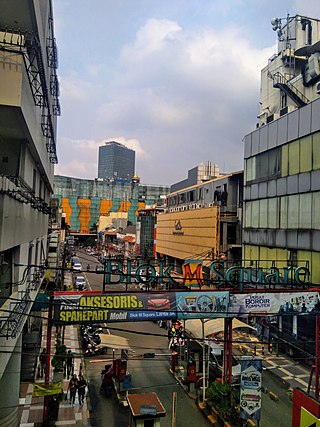
Blok M is a business and shopping quarter located in Kebayoran Baru, South Jakarta, Indonesia. It runs east from Iskandarsyah street to Bulungan street in the west. North from Falatehan street to Melawai street in the south. The development is similar to some developments near Kota, West Jakarta. On a daily basis, crowds of people throng its street, and even more so during nighttime. Much of the popularity of the quarter is due to the prices of goods, and the nightlife.

Menteng is a district in the administrative city of Central Jakarta, Indonesia. Menteng is surrounded by the districts of Senen and Matraman to the east, Tebet and Setiabudi to the south, Tanah Abang to the west, and Gambir to the north. Menteng is bound by the West Flood Canal to the west, Ciliwung River to the south and east, and Kebon Sirih Road to the north. Menteng is the district seat of the Central Jakarta government.

Pondok Indah is an upscale residential area in Pondok Pinang, Kebayoran Lama, South Jakarta, Indonesia. It is one of the most prestigious suburb areas in Jakarta, and even in Indonesia. Pondok Indah is a much sought-after suburb by expatriates, conglomerates, celebrities, and government officials.

Kebayoran Lama is a district in the administrative city of South Jakarta, Indonesia. The rough boundaries of Kebayoran Lama are: Kebayoran Lama Road – Palmerah Barat Road to the north, Grogol River to the east, Jakarta Outer Ring Road to the south, and Pesanggrahan River to the west.
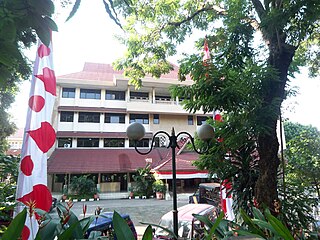
Tebet is a district in the administrative city of South Jakarta, Indonesia. The boundaries of Tebet are Jend. Gatot Subroto-Letjen Haryono MT. tollway to the south, Ciliwung River to the east, Jalan Casablanca - Ciliwung River to the north, and Cideng River to the west. This district is home to SMA Negeri 8 Jakarta
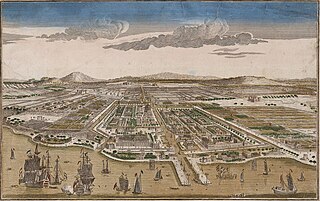
Jakarta is Indonesia's capital and largest city. Located on an estuary of the Ciliwung River, on the northwestern part of Java, the area has long sustained human settlement. Historical evidence from Jakarta dates back to the 4th century CE, when it was a Hindu settlement and port. The city has been sequentially claimed by the Indianized kingdom of Tarumanegara, the Hindu Kingdom of Sunda, the Muslim Sultanate of Banten, and by Dutch, Japanese and Indonesian administrations. The Dutch East Indies built up the area before it was taken during World War II by the Empire of Japan and finally became independent as part of Indonesia.

Pondok Aren is a town and an administrative district (kelurahan) in the city of South Tangerang, in Banten Province on Java, Indonesia. It is located on the south-western outskirts of Jakarta. The district covers 29.80 km2 and had a population of 303,093 at the 2010 Census and 294,996 at the 2020 Census; the official estimate as at mid 2023 was 295,812.
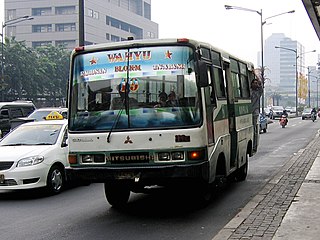
Koperasi Angkutan Jakarta or Kopaja was a cooperative established in 1971 to provide public transport services in Jakarta. There were reportedly over 1,400 minibuses in the Kopaja fleet in mid-2012, more than half of which were estimated to be over 20 years old.

The Pakubuwono is a residential complex consisting of 11 skyscrapers at Kebayoran Baru in South Jakarta, and 1 Makorewood Tower at Menteng in Central Jakarta. Indonesia.

Bintaro Jaya is a planned township located in Greater Jakarta, Indonesia. It is developed by PT Jaya Real Property Tbk. The development of the township began within South Jakarta in 1979 and is expanded further to South Tangerang in Banten province. The township is built as a satellite city for Jakarta, with a total land area of about 1000 hectares. The name Bintaro is derived from the Bintaro Village, which also takes the name of Bintaro plant, whereas Jaya came from the name of the developer. Bintaro Jaya along with Bumi Serpong Damai (BSD) is one of the largest township in Indonesia.
The Golden Triangle of Jakarta or can also be referred to as Medan Merdeka–Thamrin–Sudirman Axis or Sudirman–Thamrin–Kuningan Axis, is a roughly triangular area in the center of Jakarta, Indonesia, extending from Central Jakarta to South Jakarta. Most of the city's tallest skyscrapers, office buildings and foreign embassies are located in the area, which is the main CBD of Jakarta.

Mayestik Market is a modern traditional market at Kebayoran Baru, in Jakarta, Indonesia. Drugs and cosmetics, jewelry, clothing and tailors, vegetables and fruits, meat and fish, book store, sports equipment, almost everything needed for daily life are available in this market.

Hilman Djajadiningrat was an Indonesian aristocrat and politician.
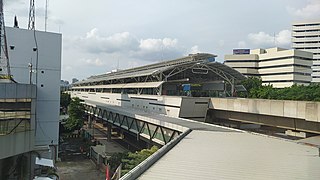
ASEAN Station is a rapid transit station on the North-South Line of the Jakarta MRT in Jakarta, Indonesia. The station is located in the Gunung area, Kebayoran Baru, South Jakarta and is built on Jalan Sisingamangaraja XII. This station is the northernmost elevated station for the first phase of the Jakarta MRT project before entering the underground line. It is located between Senayan and Blok M BCA stations, and has the station code SSM. It is connected to the TransJakarta at the. The station is located not far from the Secretariat of the Association of Southeast Asian Nations. The station is connected to the CSW-ASEAN TOD for Transjakarta's Corridor 13 service via a pedestrian bridge that has been in operation since December 2021. The station has only two railroad tracks and has no switches.

Blok M MRT Station is a rapid transit station on the North-South Line of the Jakarta MRT in Jakarta, Indonesia. The station is located on Jalan Panglima Polim Raya, Melawai, Kebayoran Baru, South Jakarta, between ASEAN and Blok A stations. Unlike other stations on the MRT network, it has three tracks, with two island platforms.

Blok A Station is a rapid transit station on the North-South Line of the Jakarta MRT in Jakarta, Indonesia. The station is located on Jalan RS Fatmawati 58, Pulo, Kebayoran Baru, South Jakarta, between Blok M BCA and Haji Nawi stations, and has the station code BLA.

Haji Nawi Station is a rapid transit station on the North-South Line of the Jakarta MRT in Jakarta, Indonesia. The station is located on Jalan RS Fatmawati 58, Gandaria Selatan, Cilandak, South Jakarta, between Blok A and Cipete Raya stations, and has the station code HJN.

Blok M Terminal is a type-B bus terminal located within the commercial and entertainment quarter of Blok M in Kebayoran Baru, Jakarta, Indonesia. It only serves city transport buses that connects several regions in Jakarta and its surrounding cities. The terminal primarily serves Transjakarta's BRT corridors and feeder routes. Perum DAMRI also operates numbers of shuttle bus services from the Soekarno–Hatta International Airport and several gated communities in Greater Jakarta to Blok M terminal. Apart from DAMRI, Mayasari Bakti and Sinar Jaya also operates their bus routes to this terminal.






